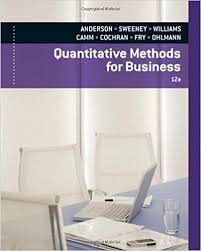Description
Test Bank For Quantitative Methods for Business 12th Edition
Chapter 5—Utility and Game Theory
MULTIPLE CHOICE
1. When consequences are measured on a scale that reflects a decision-maker’s attitude toward profit, loss, and risk, payoffs are replaced by
|
a. |
utility values. |
|
b. |
multicriteria measures. |
|
c. |
sample information. |
|
d. |
opportunity loss. |
ANS:APTS:1TOP:Meaning of utility
2.The purchase of insurance and lottery tickets shows that people make decisions based on
|
a. |
expected value. |
|
b. |
sample information. |
|
c. |
utility. |
|
d. |
maximum likelihood. |
ANS: C PTS: 1 TOP: Introduction
3.The expected utility approach
|
a. |
does not require probabilities. |
|
b. |
leads to the same decision as the expected value approach. |
|
c. |
is most useful when excessively large or small payoffs are possible. |
|
d. |
requires a decision tree. |
ANS: C PTS: 1 TOP: Expected utility approach
4.Utility reflects the decision maker’s attitude toward
|
a. |
probability and profit |
|
b. |
profit, loss, and risk |
|
c. |
risk and regret |
|
d. |
probability and regret |
ANS:BPTS:1TOP:Meaning of utility
5.Values of utility
|
a. |
must be between 0 and 1. |
|
b. |
must be between 0 and 10. |
|
c. |
must be nonnegative. |
|
d. |
must increase as the payoff improves. |
ANS: D PTS: 1 TOP: Developing utilities for monetary payoffs
6.If the payoff from outcome A is twice the payoff from outcome B, then the ratio of these utilities will be
|
a. |
2 to 1. |
|
b. |
less than 2 to 1. |
|
c. |
more than 2 to 1. |
|
d. |
unknown without further information. |
ANS:DPTS:1TOP:Meaning of utility
7.The probability for which a decision maker cannot choose between a certain amount and a lottery based on that probability is
|
a. |
the indifference probability. |
|
b. |
the lottery probability. |
|
c. |
the uncertain probability. |
|
d. |
the utility probability. |
ANS: A PTS: 1 TOP: Developing utilities for monetary payoffs
8.A decision maker has chosen .4 as the probability for which he cannot choose between a certain loss of 10,000 and the lottery p(−25000) + (1 − p)(5000). If the utility of −25,000 is 0 and of 5000 is 1, then the utility of −10,000 is
|
a. |
.5 |
|
b. |
.6 |
|
c. |
.4 |
|
d. |
4 |
ANS: B PTS: 1 TOP: Developing utilities for monetary payoffs
9.When the decision maker prefers a guaranteed payoff value that is smaller than the expected value of the lottery, the decision maker is
|
a. |
a risk avoider. |
|
b. |
a risk taker. |
|
c. |
an optimist. |
|
d. |
an optimizer. |
ANS: A PTS: 1 TOP: Risk avoiders versus risk takers
10.A decision maker whose utility function graphs as a straight line is
|
a. |
conservative. |
|
b. |
risk neutral. |
|
c. |
a risk taker. |
|
d. |
a risk avoider. |
ANS: B PTS: 1 TOP: Risk avoiders versus risk takers

Reviews
There are no reviews yet.